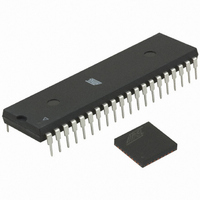ATMEGA64RZAV-10PU Atmel, ATMEGA64RZAV-10PU Datasheet - Page 31

ATMEGA64RZAV-10PU
Manufacturer Part Number
ATMEGA64RZAV-10PU
Description
MCU ATMEGA644/AT86RF230 40-DIP
Manufacturer
Atmel
Series
ATMEGAr
Datasheets
1.ATMEGA644-20MU.pdf
(23 pages)
2.ATMEGA644-20MU.pdf
(376 pages)
3.AT86RF230-ZU.pdf
(98 pages)
Specifications of ATMEGA64RZAV-10PU
Frequency
2.4GHz
Modulation Or Protocol
802.15.4 Zigbee
Power - Output
3dBm
Sensitivity
-101dBm
Voltage - Supply
1.8 V ~ 3.6 V
Data Interface
PCB, Surface Mount
Memory Size
64kB Flash, 2kB EEPROM, 4kB RAM
Antenna Connector
PCB, Surface Mount
Package / Case
40-DIP (0.600", 15.24mm)
Wireless Frequency
2.4 GHz
Interface Type
JTAG, SPI
Output Power
3 dBm
For Use With
ATSTK600-TQFP32 - STK600 SOCKET/ADAPTER 32-TQFPATAVRISP2 - PROGRAMMER AVR IN SYSTEMATSTK500 - PROGRAMMER AVR STARTER KIT
Lead Free Status / RoHS Status
Lead free / RoHS Compliant
Operating Temperature
-
Applications
-
Data Rate - Maximum
-
Current - Transmitting
-
Current - Receiving
-
Lead Free Status / Rohs Status
Lead free / RoHS Compliant
For Use With/related Products
ATmega64
- Current page: 31 of 376
- Download datasheet (8Mb)
7.4
2593N–AVR–07/10
Full Swing Crystal Oscillator
Table 7-4.
Notes:
This Crystal Oscillator is a full swing oscillator, with rail-to-rail swing on the XTAL2 output. This is
useful for driving other clock inputs and in noisy environments. The current consumption is
higher than the
Oscillator will only operate for Vcc = 2.7 to 5.5 volts.
Some initial guidelines for choosing capacitors for use with crystals are given in
crystal should be connected as described in
The operating mode is selected by the fuses CKSEL3..1 as shown in
Table 7-5.
Notes:
Table 7-6.
Oscillator Source /
Power Conditions
Crystal Oscillator, BOD
enabled
Crystal Oscillator, fast
rising power
Crystal Oscillator, slowly
rising power
Frequency Range
Oscillator Source /
Power Conditions
Ceramic resonator, fast
rising power
Ceramic resonator, slowly
rising power
Ceramic resonator, BOD
enabled
Ceramic resonator, fast
rising power
1. These options should only be used when not operating close to the maximum frequency of the
2. These options are intended for use with ceramic resonators and will ensure frequency stability
1. The frequency ranges are preliminary values. Actual values are TBD.
2. If 8 MHz frequency exceeds the specification of the device (depends on V
device, and only if frequency stability at start-up is not important for the application. These
options are not suitable for crystals.
at start-up. They can also be used with crystals when not operating close to the maximum fre-
quency of the device, and if frequency stability at start-up is not important for the application.
Fuse can be programmed in order to divide the internal frequency by 8. It must be ensured
that the resulting divided clock meets the frequency specification of the device.
0.4 - 20
Start-up Times for the Low Power Crystal Oscillator Clock Selection (Continued)
Full Swing Crystal Oscillator operating modes
Start-up Times for the Full Swing Crystal Oscillator Clock Selection
”Low Power Crystal Oscillator” on page
(1)
(MHz)
Start-up Time from
Start-up Time from
Power-down and
Power-down and
Power-save
Power-save
16K CK
16K CK
16K CK
258 CK
258 CK
1K CK
1K CK
CKSEL3..1
011
”Clock Source Connections” on page
Additional Delay
Additional Delay
14CK + 4.1 ms
14CK + 4.1 ms
14CK + 65 ms
Recommended Range for Capacitors C1
14CK + 4.1 ms
14CK + 65 ms
(V
(V
from Reset
from Reset
CC
CC
14CK
30. Note that the Full Swing Crystal
14CK
(2)
= 5.0V)
= 5.0V)
(2)
(1)
(1)
(2)
and C2 (pF)
Table
12 - 22
ATmega644
CKSEL0
CKSEL0
7-5.
CC
0
0
0
0
1
1
1
), the CKDIV8
Table
29.
SUT1..0
SUT1..0
7-6. The
00
01
10
11
01
10
11
31
Related parts for ATMEGA64RZAV-10PU
Image
Part Number
Description
Manufacturer
Datasheet
Request
R

Part Number:
Description:
DEV KIT FOR AVR/AVR32
Manufacturer:
Atmel
Datasheet:

Part Number:
Description:
INTERVAL AND WIPE/WASH WIPER CONTROL IC WITH DELAY
Manufacturer:
ATMEL Corporation
Datasheet:

Part Number:
Description:
Low-Voltage Voice-Switched IC for Hands-Free Operation
Manufacturer:
ATMEL Corporation
Datasheet:

Part Number:
Description:
MONOLITHIC INTEGRATED FEATUREPHONE CIRCUIT
Manufacturer:
ATMEL Corporation
Datasheet:

Part Number:
Description:
AM-FM Receiver IC U4255BM-M
Manufacturer:
ATMEL Corporation
Datasheet:

Part Number:
Description:
Monolithic Integrated Feature Phone Circuit
Manufacturer:
ATMEL Corporation
Datasheet:

Part Number:
Description:
Multistandard Video-IF and Quasi Parallel Sound Processing
Manufacturer:
ATMEL Corporation
Datasheet:

Part Number:
Description:
High-performance EE PLD
Manufacturer:
ATMEL Corporation
Datasheet:

Part Number:
Description:
8-bit Flash Microcontroller
Manufacturer:
ATMEL Corporation
Datasheet:

Part Number:
Description:
2-Wire Serial EEPROM
Manufacturer:
ATMEL Corporation
Datasheet:










